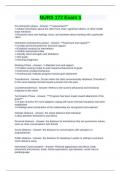NURS 172 Exam 1
Pre-interaction phase - Answer- ***assessment***
>>Obtain information about the client from chart, significant others, or other health
team members
>>Examine ones own feelings, fears, and anxieties about working with a particular
client
Orientation (introductory) phase - Answer- ***build trust and rapport***
>>Create and environment for trust and rapport
>>Establish contract for intervention
>>Gather assessment data
>>Identify client strengths and limitations
>>Set goals
>>Nursing Diagnoses
Working Phase - Answer- >>Maintain trust and rapport
>>Problem solving model to work toward achievement of goals
>>Overcome resistant behaviors
>>Continuously evaluate progress toward goal attainment
Transference - Answer- Occurs when the client unconsciously displaces ("transfers")
to the nurse feelings formed toward a person from the past
Countertransference - Answer- Refers to the nurse's behavioral and emotional
response to the client
Termination Phase - Answer- ***Progress has been made toward attainment of the
goals***
>>A plan of action for more adaptive coping with future stressful situations has been
established
>>Feelings about termination of the relationship are recognized and explored
Intimate distance - Answer- the closet distance that individual
s allow between themselves and others
Personal distance - Answer- the distance for interactions that are personal in nature,
such as close conversations with friends
Social distance - Answer- the distance for conversation with strangers or
acquaintances
Public distance - Answer- the distance for speaking in public or yelling to someone
some distance away
Nonverbal Communication - Answer- Physical appearance and dress, body
movement and posture, touch, facial expressions, eye behavior, vocal cues or
paralanguage
, Therapeutic Communication Techniques - Answer- using silence, accepting, giving
recognition, offering self, broad openings, making observations, encouraging
comparison, restating, focusing, exploring, seeking clarification and validation,
presenting reality, voicing doubt, verbalizing the implied, formulating plan of action
Non-therapeutic Communication Techniques - Answer- giving reassurance,
rejecting, approving or disapproving, agreeing or disagreeing, giving advice, probing,
defending, requesting an explanation (don't asking "why"), belittling feelings
expressed, using denial, stereotypical comments, interpreting
Active Listening (SOLER) - Answer- S-sit squarely facing the client
O-observe an open posture
L-lean forward toward the client
E-establish eye contact
R-relax
What is the most essential task for a nurse to accomplish prior to forming a
therapeutic relationship with a client?
1. Clarify personal attitudes, values, and beliefs.
2. Obtain thorough assessment data.
3. Determine the client's length of stay
4. Establish personal goals for interaction - Answer- 1. Clarify personal attitudes,
values, and beliefs.
If a client demonstrates transference toward a nurse, how should the nurse respond?
1. Promote safety and immediately terminate the relationship with the client.
2. Encourage the client to ignore these thoughts and feelings.
3. Immediately reassign the client to another staff member.
4. Help the client to clarify the meaning of the relationship, based on the present
situation. - Answer- 4. Help the client to clarify the meaning of the relationship, based
on the present situation.
What should be the priority nursing action during the orientation phase of the nurse-
client relationship?
1. Acknowledge the client's actions, and generate alternative behaviors.
2. Establish rapport and develop treatment goals.
3. Attempt to find alternative placement
4. Explore how thoughts and feelings about this client may adversely impact nursing
care. - Answer- 2. Establish rapport and develop treatment goals.
Which client action should a nurse expect during the working phase of the nurse-
client relationship?
1. The client gains insight and incorporates alternative behaviors.
2. The client establishes rapport with the nurse and mutually develops treatment
goals.




